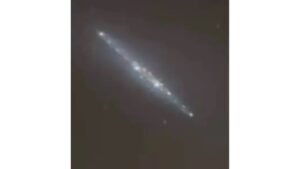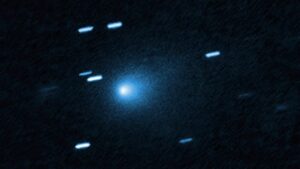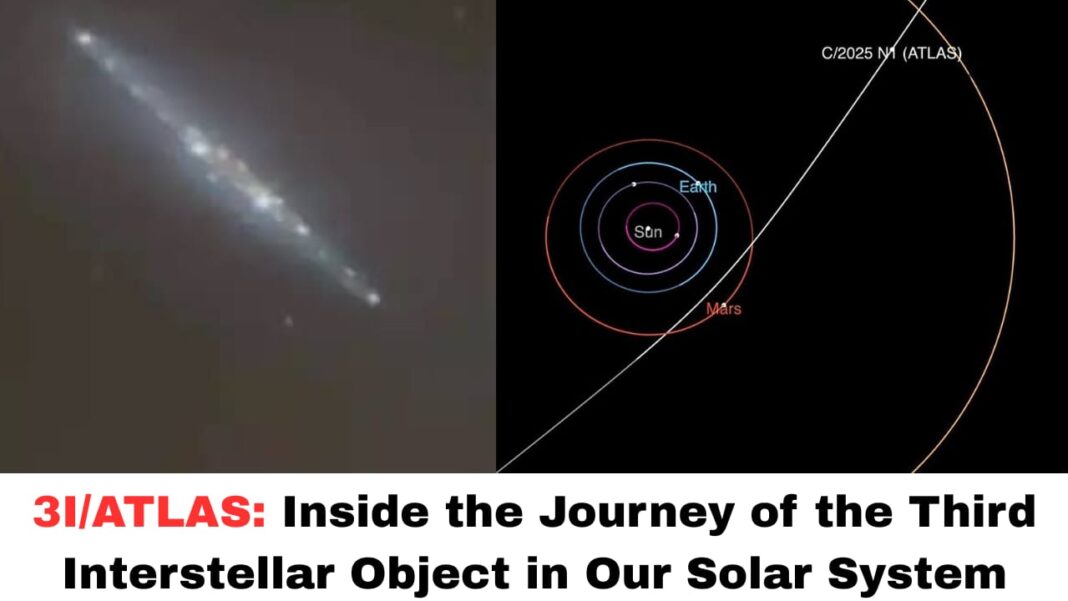Digital News Guru Current Affairs Desk:
What is 3I/ATLAS?
On 1 July 2025, the Asteroid Terrestrial‑impact Last Alert System (ATLAS) survey telescope in Chile first identified the object, later confirmed to be interstellar in origin because of its hyperbolic trajectory.
Analyses indicate 3I/ATLAS is moving at roughly 60 km/s (≈ 37 miles/s) relative to the Sun, and is on a path that will take it inside the orbit of Mars, but crucially — it will not come close enough to pose any threat to Earth. According to NASA, its closest approach to the Sun will be around 30 October 2025 at about 1.4 astronomical units (AU) from the Sun (≈ 210 million km) and its distance to Earth will stay at least around 1.8 AU (≈ 270 million km).
Because of its high speed and incoming direction, astronomers are confident it came from outside our Solar System — making it only the third such object ever documented, after 1I/ʻOumuamua (2017) and 2I/Borisov (2019).

Unusual Features & Composition
What makes 3I/ATLAS truly interesting are its physical and chemical features, which set it apart from many “ordinary” Solar‐System comets.
Cometary behaviour
Although initially its nature (asteroid vs comet) was unclear, subsequent observations revealed a faint “coma” (a cloud of gas/dust) and tail-like structure.
Imaging from the Hubble Space Telescope on 21 July 2025 captured the nucleus and surrounding dust cocoon.
Composition surprises
What is particularly striking:
- Infrared spectroscopy shows a coma dominated by carbon dioxide (CO₂) relative to water (H₂O) — a CO₂/H₂O mixing ratio of approximately 8:1, which is among the highest ever measured for a comet.
- Ultraviolet observations revealed hydroxyl (OH) emissions — a by-product of water — when the object was still far (~3.5 AU) from the Sun, where water ice typically does not sublimate much. This indicates unusually early activity.
- Polarimetric studies show a deep and narrow “negative polarisation branch” (light‐scattering characteristic) down to -2.7% at small phase angles — a behaviour unprecedented among known Solar-System comets and asteroids.
In sum, the object appears to be a comet-like body that may have formed under different conditions than typical comets in our Solar System, perhaps exposed to higher radiation or deriving from a region where CO₂-ice formation was favoured.
Size & scale
Some estimates (though with caveats) suggest 3I/ATLAS might be quite large for an interstellar visitor—possibly tens of kilometres across in its nucleus.

Why It Matters
The arrival of 3I/ATLAS offers a rare and invaluable scientific opportunity — essentially a messenger from another star system that we can observe up close (relatively speaking).
- Comparative planetology: By studying its ice, gas and dust composition, we glean clues about how other star systems form comets/planetesimals — are they like ours or fundamentally different?
- Volatile chemistry: The unusual CO₂‐rich nature invites questions about volatile storage and release in such bodies — how did this object retain CO₂ so strongly, or why is water so suppressed?
- Formation clues: If 3I/ATLAS formed in a low‐metallicity, radiation-intense or otherwise different protoplanetary disk, it may carry “pristine” information about environments unlike ours.
- Interstellar visitor population: Each interstellar object we detect helps refine how many such wanderers traverse our Galaxy, how many we might detect with upcoming surveys, and what biases we have in observation.
- Public engagement: Such an object captures the imagination — a rock (or ice‐rock) from another star system passing through ours is a powerful story.
Observing It & What to Expect
While a naked‐eye spectacle is unlikely, the object is being tracked by major telescopes and will become observable by amateur equipment with good sky conditions.
- Through September 2025 the object was visible from Earth with telescopes, but its elongation (angle from the Sun) will shrink as it heads toward perihelion, making observations more difficult from Earth around late October.
- After perihelion, it is expected to reappear in our dawn skies by early December, moving through the constellations Virgo and Leo.
- For observers in India: given the object’s faintness, light pollution, and the fact that Earth will be on the far side relative to the comet at perihelion, best chances will be with a decent telescope, good sky conditions, and timing near dawn or dusk when the object’s solar elongation increases again.

Open Questions & Speculation
Despite the wealth of data, many questions remain:
- What is the precise size of the nucleus? Estimates diverge due to coma contribution to brightness.
- What is the exact origin of the object (which star system or stellar neighborhood)? Hard to trace from current data.
- Why is water activity so unusual (either suppressed or delayed) while CO₂ is dominant?
- Do the extreme polarisation and dust grain size/distribution signal a fundamentally different formation environment?
- Some scientists (notably Avi Loeb) have speculated about non‐natural (technological) origins given oddities in behaviour, though the consensus remains strongly in favour of a natural cometary body. Medium+2Medium+2
Conclusion
3I/ATLAS is more than just a new comet — it’s a rare interstellar visitor, offering a fleeting window into the chemistry and physics of other planetary systems. As it swoops through our Solar System, it challenges our expectations: telling us that not all comets are alike, that the volatile inventory of a small body from another system can differ dramatically, and that every such visitor enriches our understanding of the cosmic neighbourhood.
For astronomers, this object is a treasure. For the public, it’s a reminder that our Solar System is not isolated — the Milky Way is full of wanderers. And for all of us, it is an invitation: look up, wonder, and observe — this particular visitor is here only briefly before it returns to the depths of space.
You May Also Read: Himesh Reshammiya Makes Kannada Singing Debut in Ruby








